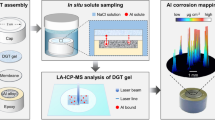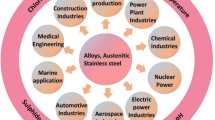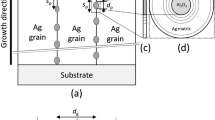Abstract
Aluminium was anodised in H2SO4 solutions 0.25–1.53 M, temperatures 0–35 °C, times up to 90 min and voltage 25 V. Anodising was followed chronoamperometrically. The passing charge, consumed Al, formed oxide, transport numbers of oxygen anions in barrier layer and film thicknesses were determined. Films were examined to detect abnormal film growth, called burning. It was found that the current in Al anode is closely solely ionic, and the only processes occurring are those related with ionic charge transport and heat release and its abduction for which suitable equations were formulated relating many parameters. At each concentration, the temperatures, current densities and times up to which normal film growth occurs and above which stain-like mild, island-like intermediate, strong, strong-destructive and mixed burning appears were found. Burning emerges at lower concentrations, temperatures and times for thinner Al. Low concentrations and temperatures among thresholds where mild and next-kind burning first appear define windows of conditions where thick enough dark or black films grow. Peculiar chronoamperometric plot characterises each film growth type. Though other burning kinds can appear at each surface region or in the whole surface, strong and strong-destructive emerge only at the lower Al side around which the efficiency of solution stirring is highest. The mechanisms of normal and abnormal film growth were formulated showing that different processes and interacting variable parameters, some of which are noted for first time, regulate each film growth type. These can predict methods to avoid abnormal film growth.









Similar content being viewed by others
Abbreviations
- a 2 and a 3 :
-
Activation (half jump) distances of O2−and Al3+ transport inside the barrier layer (nanometres)
- Al3+ aq,hydr :
-
Hydrated Al3+ in aqueous solution
- AM Al :
-
Atomic mass of Al
- A 2 and A 3 :
-
N 2,m v 2 n 2 FN A −1 and N 3,m v 3 n 3 FN A −1 (milliamperes per square centimetre)
- A 2,a and A 3,a :
-
Average A 2 and A 3 across the barrier layer (milliamperes per square centimetre)
- B 2 :
-
n 2 a 2 and B 3 = n 3 a 3 (manometres)
- c a :
-
Concentration of H2SO4 anodising electrolyte (Molar)
- C p,Al :
-
Molar heat capacity of Al (joules per mole per Kelvin)
- d Al :
-
Density of Al (2.7 g cm−3)
- D, D b and D c :
-
Diameter of the hemispherical section surface across the barrier layer, pore base diameter and cell width in steady state (nanometres)
- 2−1(D c–D b):
-
Barrier layer thickness (nanometres)
- ΔH :
-
Enthalpy change between ordinary and transient oxide lattice structures (joules per mole)
- ΔH a :
-
Average ΔH across the barrier layer (joules per mole)
- ΔH o 298 K(Al):
-
Standard formation enthalpy of Al (kilojoules per mole)
- ΔH o 298 K(Al2O3):
-
Standard formation enthalpy of Al2O3 (kilojoules per mole)
- ΔH o 298 K(Al3+):
-
Standard formation enthalpy of Al3+ (kilojoules per mole)
- ΔH o 298 K,hydr(Al3+):
-
Standard hydration enthalpy of Al3+ (kilojoules per mole)
- ΔH o 298 K(H+):
-
Standard formation enthalpy of H+ (kilojoules per mole)
- ΔH o 298 K,hydr(H+):
-
Standard hydration enthalpy of H+ (kilojoules per mole)
- ΔH o 298 K(H2Ol):
-
Standard formation enthalpy of liquid H2O (kilojoules per mole)
- ΔH r o 298 K and ΔH r o T :
-
Standard enthalpy (per mol of Al2O3) of reaction 2Al + tn an3H2O = tn anAl2O3 + tn an6H+ aq,hydr + tn ca2Al3+ aq,hydr + 6e−(kilojoules per mole) and this enthalpy at T ≠ 298 K
- Δm :
-
Difference of Al anode mass after and before anodising (grams)
- ΔP bl, ΔP pfs, ΔP attl and ΔP bs :
-
Potential drops across the barrier layer, in pore-filling solution, in attached layer and in adjacent bath solution layer up to reference electrode (volts)
- E :
-
local field strength in each equipotential surface across the barrier layer (volts per nanometre)
- E a = 2ΔP bl(D c–D b)−1 :
-
Average field strength across the barrier layer (volts per nanometre)
- E pfs, E attl and E bs :
-
Field strength in pore-filling solution, attached layer and adjacent bath solution layer up to reference electrode across each plane parallel to film surface (volts per micrometre)
- F :
-
Faraday’s constant (96,487 C mol−1)
- h f, h, h attl and h bs :
-
Film thickness, length of pores (≈ h f) and thicknesses of attached layer and adjacent layer up to reference electrode (micrometres)
- H+ aq,hydr :
-
Hydrated H+ in aqueous solution
- j and j a :
-
Current density and average current density during potentiostatic anodising (milliamperes per square centimetre)
- j pfs, j attl and j bs :
-
Ionic current density in pore-filling solution, attached layer and adjacent bath solution layer up to reference electrode across each plane parallel to film surface (milliamperes per square centimetre)
- k :
-
Rate constant of film thickness increase 6.9833 × 10−5 cm3 C−1
- k ht,ox, k ht,pfs and k ht,attl :
-
Thermal conductivity of oxide, pore-filling solution and attached layer (watt per centimetre per Kelvin)
- k ht,f :
-
Combined thermal conductivity of oxide and pore-filling solution (watt per centimetre per Kelvin)
- k ht,t :
-
Total coefficient of heat transport from Al anode to bath solution (watt per square centimetre per Kelvin)
- l Al,0 :
-
Initial Al metal thickness (millimetres)
- l Al = l Al,0–S Al −1 d Al −1 AM Al Q(3 F)−1 :
-
Mean thickness of Al metal remaining unconsumed during anodising (millimetres)
- me:
-
Metal
- m|o:
-
Metal|oxide interface
- m Al :
-
Mass of Al remaining unconsumed during anodising (grams)
- m Al,sod :
-
Consumed Al mass found by selective oxide dissolution (grams or milligrams)
- m ox,mb :
-
Mass of oxide found by the mass balance method (grams or milligrams)
- m ox,sod :
-
Mass of oxide found by its selective dissolution (grams or milligrams)
- n :
-
Surface density of oxide cells/pores near Al substrate surface in steady state (per square centimetre)
- n 2 and n 3 :
-
Valences of O2−and Al3+ ions
- N A :
-
Avogadro constant (6.022 × 1023 mol−1)
- N 2,m and N 3,m :
-
Surface concentrations of mobile O2−and Al3+ in each equipotential surface across the barrier layer (per square centimetre)
- v 2 and v 3 :
-
Vibration frequencies of O2−and Al3+ ions or the number of chances per s the ions may jump the energy barrier (activation energy) if they have sufficient energy (per second)
- o|e:
-
Oxide|electrolyte interface
- ox:
-
Oxide
- p and p a :
-
Local porosity at each position across the film and average porosity of the entire film (dimensionless)
- P an :
-
Anodic potential versus SHE (volts)
- P an–P cath :
-
Potential difference between anode and cathode or anodising voltage (volts)
- P an–P ref :
-
Potential difference between anode and reference electrode (volts)
- Q :
-
Passing electric charge (coulomb)
- Q ac,Al, Q ac,ox, Q ac,pfs and Q ac,attl :
-
Heat accumulated in Al metal substrate, oxide, pore-filling solution and attached layer (joules)
- R :
-
Universal gas constant (8.314 J K−1 mol−1)
- R pfs, R attl and R bs :
-
Ohmic resistances in pore-filling solution, attached layer and adjacent bath solution layer up to reference electrode (ohm)
- S:
-
Equipotential hemispherical surface across the barrier layer
- SS:
-
Plane across the film parallel to film and Al substrate surfaces
- S’S’:
-
Outer boundary plane of attached layer on Al anode
- S Al :
-
One face entire geometric surface area of Al specimen (square centimetres)
- S g :
-
Geometric surface area of Al specimens that is oxidised during anodising (square centimetre)
- S = 2−1 S g πnD 2 :
-
Area of hemispherical surface with diameter D across the barrier layer per unit of S g (square centimetres)
- S a :
-
Average S across the barrier layer ≈ 2−1 S g(2.093 + 2−1 πnD b 2) (square centimetres)
- t :
-
Anodising time (minutes or seconds)
- tn an and tn ca :
-
Transport numbers of O2−and Al3+ across the barrier layer (dimensionless)
- tn an,a :
-
Average tn an when j and/or T an vary during anodising (dimensionless)
- T :
-
Temperature of bath bulk solution (degrees Centigrade or Kelvin)
- T an :
-
Real anodising temperature in the barrier layer region (degrees Centigrade or Kelvin)
- T fs :
-
Temperature at film surface during anodising (degrees Centigrade or Kelvin)
- u i,pfs, u i,attl and u i,bs,:
-
Specific ionic conductance (conductivity) of i species in pore-filling solution, attached layer and adjacent bath solution layer up to reference electrode at each plane parallel to film surface (per ohm per micrometre)
- û i,pfs, û i,attl and û i,bs :
-
Average u i,pfs, u i,attl and u i,bs along pores and in attached and adjacent layer (per ohm per micrometre)
- W 2 and W 3 :
-
Real activation energies of O2−and Al3+ transport across the barrier layer (joules per mole)
- W 2,a and W 3,a :
-
Average W 2 and W 3 across the barrier layer (joules per mole)
References
Sheasby PG, Pinner R (2001) The surface treatment and finishing of aluminium and its alloys, 6th edn. ASM International & Finishing Publications Ltd, USA-UK
Martin CR (1996) Chem Mater 8:1739–1746
Kovtyukhova N, Mallouk TE (2005) Adv Mater 17:187–192
Sulka GD (2008) Highly ordered anodic porous alumina formation by self-organized anodizing. In: Eftekhari A (ed) Nanostructured materials in electrochemistry. Wiley-VGH, Wienheim
Ganley JC, Riechmann KL, Seebauer EG, Masel RI (2004) J Catal 227(1):26–32
Pellin MJ, Stair PC, Xiong G, Elam JW, Birrell J, Curtiss L, George SM, Han CY, Iton L, Kung H, Kung M, Wang HH (2005) Catal Lett 102(3–4):127–130
Surganov VF, Gorokh GG (1993) Mater Lett 17:121–124
Surganov V, Janson C, Nielsen JCG, Morgen P, Gorokh G, Larsen AN (1988) Electrochim Acta 33:517–519
Dell’Oca CJ, Fleming PJ (1976) J Electrochem Soc 123:1487–1493
Parkhutik VP (1986) Corros Sci 26:295–310
Parkhutik VP, Shershulsky VI (1992) J Phys D Appl 25:1258–1263
Patermarakis G, Chandrinos J, Masavetas K (2007) J Solid State Electrochem 11:1191–1204
Jessensky O, Müller F, Gösele U (1998) Appl Phys Lett 72(10):1173–1175
Zhang L, Cho HS, Li F, Metzger RM, Doyle WD (1998) J Mater Sci Lett 17:291–294
Jessensky O, Müller F, Gösele U (1998) J Electrochem Soc 145:3735–3740
Nielsch K, Choi J, Schwirn K, Wehrspoh RB, Gösele U (2002) Nano Lett 2(7):677–680
Li AP, Müller F, Birner A, Nielsch K, Gösele U (1997) J Appl Phys 84(11):6023–6026
Li AP, Müller F, Gösele U (2000) Electrochem Solid State Lett 3(3):131–134
Masuda H, Yotsuy M, Asano M, Nishio K, Nakao M, Yokoo A, Tamamura T (2001) Appl Phys Lett 78(6):826–828
Pan H, Lin J, Feng Y, Gao H (2005) IEEE Transac Nanotechnol 3:462–467
Keller F, Hunter MS, Robinson DL (1953) J Electrochem Soc 100:411–419
Diggle JW, Downie TC, Goulding CW (1969) Chem Rev 69:365–405
Young L (1961) Anodic Oxide Films. Academic Press, London
Thompson GE, Furneaux RC, Wood GC (1978) Corros Sci 18:481–498
Patermarakis G, Lenas P, Karavassilis C, Papayiannis G (1991) Electrochim Acta 36:709–725
Patermarakis G, Kerassovitou P (1992) Electrochim Acta 37:125–137
Napolskii KS, Roslyakov IV, Eliseev AA, Petukhov AV, Byelov DV, Grigiryeva NA, Bouwman WG, Lukashin AV, Kvashnina KO, Chumacov AP, Grigoryev SV (2010) Appl Crystallogr 43:531–538
Masuda H, Asoh H, Wanatab M, Nishio M, Nakao M, Tamamura T (2001) Adv Mater 13:189–192
Kustandi TS, Loh WW, Gao H, Low HY (2010) ACS Nano 4(5):2561–2568
Masuda H, Fukuda K (1995) Science 268:1466–1468
Sulka GD, Stroobants S, Moshehalkov V, Borghs G, Celis JP (2002) J Electrochem Soc 149(7):D97–D103
Masuda H, Hasegwa F, Ono S (1997) J Electrochem Soc 144:L127–L130
Li F, Zhang L, Metzger RM (1998) Chem Mater 10:2470–2480
Patermarakis G (2009) J Electroanal Chem 635:39–50
Montero-Moreno JM, Sarret M, Müller C (2010) Micropor Mesopor Mat 136:68–74
Brace AW (1992) Anodic Coating Defects. Technicopy Books, Stonehouse, Glos, England
Brace AW (2000) The technology of anodizing aluminium. Interall S.r.l, Modelna
Patermarakis G, Tzouvelekis D (1994) Electrochim Acta 39:2419–2429
Patermarakis G, Moussoutzanis K (2001) Corros Sci 43:1433–1464
Tu GC, Chen IT, Shimizu K (1990) J Japan Inst Light Metals 40(5):382–389
Thompson DA (1961) Trans Inst Metal Fin 12(7):148–150
Thompson DA (1976) Trans Inst Metal Fin 54:97–103
Scott BA (1965) Trans Inst Metal Fin 43:1–8
Pernick J (1988) Plating and Surf Fin 75(6):32–34
Hoshin OS, Matsumoto S (1986) Metal Fin 84(7):31–35
Hoshino S, Imamura T, Matsumoto M, Kojima K (1977) J Metal Fin Soc Japan 28(3):167–171
Chu SZ, Wada K, Inoue S, Isogai M, Yasumori A (2005) Adv Mater 17:2115–2119
Lee W, Kim JC, Gösele U (2010) Adv Funct Mater 20:21–27
Moradi M, Noormohammadi M, Behzadi F (2011) J Phys D: Appl Phys 44:045301, 7 pp
Li Y, Zheng M, Ma L, Shen W (2006) Nanotechnology 17:5101–5105
Patermarakis G, Moussoutzanis K (2009) Electrochim Acta 54:2434–2443
Patermarakis G, Moussoutzanis K (2011) J Electroanal Chem 659:176–190
Davies CW (1967) Electrochemistry. Newness, London
Patermarakis G, Diakonikolaou J (2012) J Solid State Electrochem 16:2921–2939
Patermarakis G, Karayianni H, Masavetas K, Chandrinos J (2009) J Solid State Electrochem 13:1831–1847
Patermarakis G, Moussoutzanis K (1995) Electrochim Acta 40:699–708
Vogel AI (1976) Macro and semimicro quantitative analysis. Longman, London
Alexeyev VN (1980) Qualitative chemical analysis. Mir Publishers, Moscow
Dodos D (1975) Electrochemical data. Elsevier, Budapest
Koryta J, Dvořak J, Bocháčková V (1970) Electrochemistry. Methuen, London
Samsonov GV (1973) The oxide handbook. IFI/Plenum, New York
Karapetyants MK (1978) Chemical thermodynamics. Mir, Moscow
Weast RC (ed) (1980) Handbook of chemistry and physics, 60th edn. Boca Raton, CRC
Perry RH, Green DW (1999) Perry’s chemical engineers’ handbook, 7th ed. New York, NY, McGraw–Hill
Patermarakis G, Moussoutzanis K (2005) J Solid State Electrochem 9:205–233
Patermarakis G (2006) J Solid State Electrochem 10:211–222
Author information
Authors and Affiliations
Corresponding author
Rights and permissions
About this article
Cite this article
Patermarakis, G., Kapiris, G. Processes, parameters and mechanisms controlling the normal and abnormal growth of porous anodic alumina films. J Solid State Electrochem 17, 1133–1158 (2013). https://doi.org/10.1007/s10008-012-1976-0
Received:
Revised:
Accepted:
Published:
Issue Date:
DOI: https://doi.org/10.1007/s10008-012-1976-0




